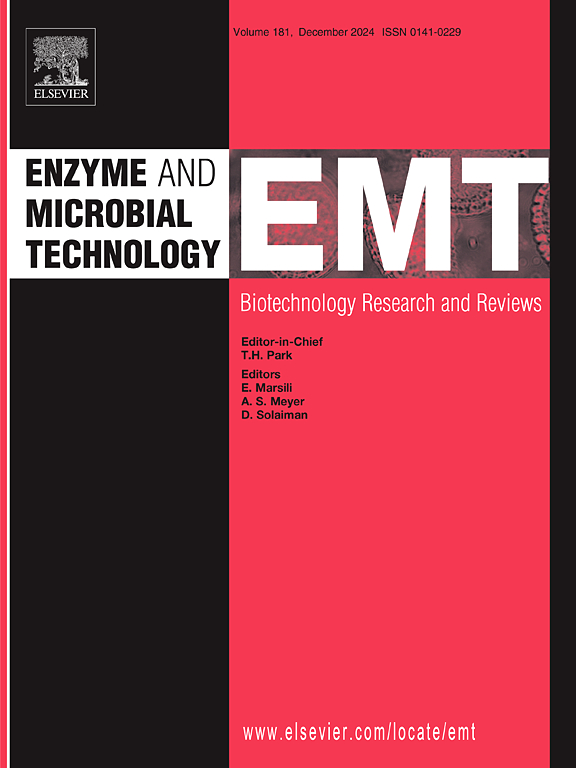嗜热真菌拉森氏d-氨基酸氧化酶独特底物特异性的结构决定因素
IF 3.7
3区 生物学
Q2 BIOTECHNOLOGY & APPLIED MICROBIOLOGY
引用次数: 0
摘要
d-氨基酸氧化酶来自嗜热真菌雷森氏菌(Rasamsonia emersonii, ReDAAO),由于其高稳定性和广泛的底物特异性而引起了人们的关注,使其成为各种应用的有前途的候选物。在这项研究中,我们探索了ReDAAO独特底物特异性的结构因素,特别是其广泛的底物范围和d-Glu氧化能力。将ReDAAO与TdDAAO(一种来自嗜热真菌的同源d-氨基酸氧化酶)进行比较,发现ReDAAO缺乏TdDAAO中存在的YVLQG环,其底物特异性较窄。将YVLQG环插入到ReDAAO中缩小了其底物特异性以与TdDAAO相匹配,而从TdDAAO中删除该序列则扩大了其底物特异性,与ReDAAO相似。TdDAAO结构模型表明,YVLQG环可以与覆盖活性位点的空间相邻区域相互作用,这与daao中典型的活性位点盖子不同,从而产生限制进入催化袋的空间位阻。此外,ReDAAO对d-Glu的意外活性似乎取决于Arg97和Ser231,它们可能与d-Glu侧链相互作用。这些残基上的丙氨酸取代显著降低了d-Glu活性,表明Arg97对于催化转化至关重要,而Ser231对于底物结合至关重要。综上所述,这些结果表明YVLQG环与空间相邻区域一起作为一个空间门,调节进入催化袋,Arg97/Ser231在d-Glu中起重要作用。这些发现加深了我们对DAAO结构-功能关系的理解,并为开发用于工业应用的改进DAAO变体提供了基础。本文章由计算机程序翻译,如有差异,请以英文原文为准。
Structural determinants of unique substrate specificity of d-amino acid oxidase of the thermophilic fungus Rasamsonia emersonii
d-Amino acid oxidase from the thermophilic fungus Rasamsonia emersonii (ReDAAO) has garnered attention due to its high stability and broad substrate specificity, making it a promising candidate for various applications. In this study, we explored the structural factors underlying the unique substrate specificity of ReDAAO, particularly its broad substrate range and d-Glu oxidation ability. Comparing ReDAAO with TdDAAO—a homologous d-amino acid oxidase from the thermophilic fungus Thermomyces dupontii—revealed that ReDAAO lacks the YVLQG loop present in TdDAAO, which exhibited narrower substrate specificity. Inserting the YVLQG loop into ReDAAO narrowed its substrate specificity to match TdDAAO, while deleting the sequence from TdDAAO broadened its substrate specificity, resembling ReDAAO. A TdDAAO structural model suggests that the YVLQG loop could interact with a spatially adjacent region covering the active site, distinct from the canonical active-site lid in DAAOs, creating steric hindrance that limits access to the catalytic pocket. Additionally, the unexpected activity of ReDAAO toward d-Glu appears to depend on Arg97 and Ser231, which could interact with d-Glu side chain. Alanine substitutions at these residues significantly reduced d-Glu activity, revealing that Arg97 is essential for catalytic turnover while Ser231 is critical for substrate binding. Together, these results suggest that the YVLQG loop together with the spatially adjacent region acts as a steric gate that modulates access to the catalytic pocket, and Arg97/Ser231 plays an important role in d-Glu. These findings deepen our understanding of the structure–function relationship of DAAO and provide a foundation for developing improved DAAO variants for industrial applications.
求助全文
通过发布文献求助,成功后即可免费获取论文全文。
去求助
来源期刊

Enzyme and Microbial Technology
生物-生物工程与应用微生物
CiteScore
7.60
自引率
5.90%
发文量
142
审稿时长
38 days
期刊介绍:
Enzyme and Microbial Technology is an international, peer-reviewed journal publishing original research and reviews, of biotechnological significance and novelty, on basic and applied aspects of the science and technology of processes involving the use of enzymes, micro-organisms, animal cells and plant cells.
We especially encourage submissions on:
Biocatalysis and the use of Directed Evolution in Synthetic Biology and Biotechnology
Biotechnological Production of New Bioactive Molecules, Biomaterials, Biopharmaceuticals, and Biofuels
New Imaging Techniques and Biosensors, especially as applicable to Healthcare and Systems Biology
New Biotechnological Approaches in Genomics, Proteomics and Metabolomics
Metabolic Engineering, Biomolecular Engineering and Nanobiotechnology
Manuscripts which report isolation, purification, immobilization or utilization of organisms or enzymes which are already well-described in the literature are not suitable for publication in EMT, unless their primary purpose is to report significant new findings or approaches which are of broad biotechnological importance. Similarly, manuscripts which report optimization studies on well-established processes are inappropriate. EMT does not accept papers dealing with mathematical modeling unless they report significant, new experimental data.
 求助内容:
求助内容: 应助结果提醒方式:
应助结果提醒方式:


